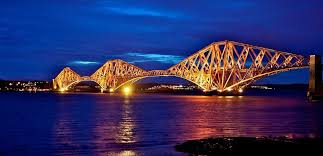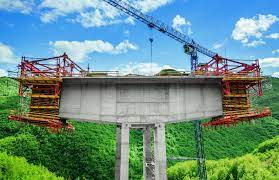A cantilever bridge comprises structures that protrude horizontally into space and are only supported on one end. A cantilever is something like a balcony that protrudes from a building. The cantilevers on small footbridges may be simple beams; however, major cantilever bridges designed to handle road or rail traffic require structural steel trusses or prestressed concrete box girders. The steel truss cantilever bridge was a great engineering accomplishment initially implemented. It can span over 460 meters (1,500 feet) and be built more simply at challenging crossings due to the lack of falsework (temporary supports). The Hassfurt Bridge spans the Main River in Germany and has a central span of 38 meters (124 feet), considered the first contemporary cantilever bridge.

Fig 1: Cantilever Bridge
Courtesy:amusingplanet.com
Two cantilever arms extending from opposite sides of an obstruction to be traversed meet in the middle to produce a basic cantilever span. The cantilever arms do not meet in the middle of a frequent form, the suspended span; instead, they support a central truss bridge that rests on the ends of the cantilever arms. The suspended span can be created off-site and lifted or erected using specific traveling supports. Steel truss and prestressed concrete cantilever spans are commonly constructed by counterbalancing one cantilever arm with another cantilever arm protruding in the opposite direction.
The following are the two types of cantilever bridges:
1. Balance Cantilever Bridges
2. Continuous Cantilever Bridges
1. Balance Cantilever Bridges:

Fig 2: Balance Cantilever Bridges:
Courtesy: structureae.net
The balanced cantilever method is used for bridges with few spans ranging from 50 to 250 meters. The bridge can be precast or cast-in-place. Furthermore, the main notion of the balanced cantilever construction method is to alternately attach segments at opposing ends of cantilevers supported by piers. This approach can easily adapt to irregular and long span lengths, congested project sites, rugged and water topography, rail crossings, and environmentally sensitive places. It is also ideal for the construction of cable-stayed bridges. In each erection stage, new cable stays will support the segments once they have been put. As a result, no auxiliary supports are required, making it cost-effective and feasible for long cable-stayed bridges. With only one cantilever, the length of the structure should be kept short to avoid uplift at the other end. The advantages of a cantilever balance bridge are that it is both easily supported and has a continuous construction. Cantilever balance bridges, like continuous bridges, required only one line of bearings over the piers.
2.Continuous Cantilever Bridges:

Fig 3: Continuous Cantilever Bridges
Courtesy: civiljungle.com
Continuous cantilever bridges are unique bridges built by attaching two gantries from opposite ends of the abutments to the center of the structure to finish the structure. The Abutments should be made heavy to compensate for the lack of a balanced cantilever. Continuous Cantilever bridges comprise a continuous beam spanning two supports while preserving its bending moment and shear strength. For structural stability, continuous truss bridges rely on stiff truss connections.
Advantages of Cantilever Bridges:
- Only one side support is supplied in each cantilever in this bridge.
- Except for the pier, such bridges do not require falsework (temporary, supporting structure during building).
- These bridges are appropriate for situations where falsework is risky or difficult to construct, such as deep, rocky gorges and rivers prone to flooding.
- During the bridge’s construction, which is done from each support pier, navigation below the bridge is not obstructed. Bridges are frequently constructed across roads and challenging crossings, allowing uninterrupted traffic flow.
- Because the beams can be attached at the extremities of the cantilevers, the span (section of a bridge between two adjacent piers) of these bridges can be longer than traditional beams.
- Suspended truss bridges (assembled sections) are simple to raise and connect two cantilever spans.
- The deck (bridge surface) can be simply built-in segments, ensuring quality and regularity.
- The repeated nature of the job is ensured by the segmental design.
- Because most bridges have multiple cantilever spans, the building can begin concurrently from all columns, cutting down on time.
- Cantilever decks have a higher density than typical bridge decks, giving them more stiffness. It allows them to carry big locomotives, which can be difficult with suspension bridges.
- In regions with a solid rock structure, the anchor arms can be directly attached to the surrounding rock without the need for artificial support.
- Because the bridge has no solid attachments, it can endure vertical ground changes to some extent, which can be harmful to other bridges.
- These bridges better tolerate the effects of thermal expansion and ground movement than others.
Disadvantages of Cantilever Bridges:
- Massive quantities of stress were formed during the construction of these bridges.
- The cantilever bridge generates compressive and tensile forces. The stability of enormous forces necessitates the use of a large structure.
- In this form of bridge, being a member of a joint section causes disability on the RCC floor.
- This sort of bridge is not ideal for places where the weather is harsh.
- A large and robust support pier is required for the cantilever arm of the cantilever bridge.
- A truss bridge is connected between two cantilevers in a suspended span for a big span bridge in this form of the bridge.
- Because of its enormous foundation structures, this sort of bridge is difficult to build and maintain.
- These bridge depths can be risky or difficult to falsework for rocky valleys and wet places.
- This bridge is not suitable in earthquake-prone locations or restricted rock stabilization.
Conclusion:
Two cantilever arms stretch from opposite sides of an obstruction to be traversed and meet in the middle of a simple cantilever bridge. Cantilever bridges can be constructed without falsework beneath them or temporary support towers and cables above them. One of their major advantages is this. They’re also built with a lot of rigidity, so they can handle a lot of weight without causing damage to the structure.
References:
1.Cantilever Bridge: Types, Advantages, And Disadvantages. (2020, May 20). Constructionor.Com. https://constructionor.com/cantilever-bridge/.
2.Rajput, K. (2021, December 30). Cantilever Bridge | Cantilever Bridge Advantages And Disadvantages | Cantilever Bridge Facts. Civil Jungle. https://civiljungle.com/cantilever-bridges.
3.What Is Cantilever Bridge? Types Of Cantilever Bridges. Advantages and Disadvantages. (2021, December 12). The Engineering Community. https://www.theengineeringcommunity.org/what-is-cantilever-bridge-types-of-cantilever-bridges-advantages-and-disadvantages.
4.How Do Cantilever Bridges Function? Ten Longest Cantilever Bridges Around the World – CivilEngineeringBible.com. (n.d.). CivilEngineeringBible.com. https://civilengineeringbible.com/article.php?i=228.
If you have a query, you can ask a question here.



The major disadvantages to a cantilever bridge is that it rests on small supports, which are easily dislodged by something like a container ship…oh, wait…we have actual live footage of what happens to a poorly designed bridge when that happens, don’t we? And where is that bridge now?
Another major disadvantage is the number of failure points. And as we know, maintenance requirements for a cantilever bridge are astronomical, and the work is dangerous, and difficult. Again, we have clear evidence of why these bridges are all dangerous accidents waiting to happen. The Key bridge collapsed in precisely the way it would, given th4e poor design. It was entirely predictable.
It is time for all engineers to stop defending this disaster of antiquated engineering. Cantilever bridges were designed by engineers who didn’t have enough information. Now that we do have that information, it is time to start figuring out how we’re going to replace them.